Albino cory catfish or Albino Aeneus Cory Cat is a Corydoras spp. that is famous in the aquarium industry.
Albino Corys are one of the first bottom-feeding fish that aquarists purchase because they are peaceful, active, and easy to care for. Let’s talk about Albino Cory catfish in this article.
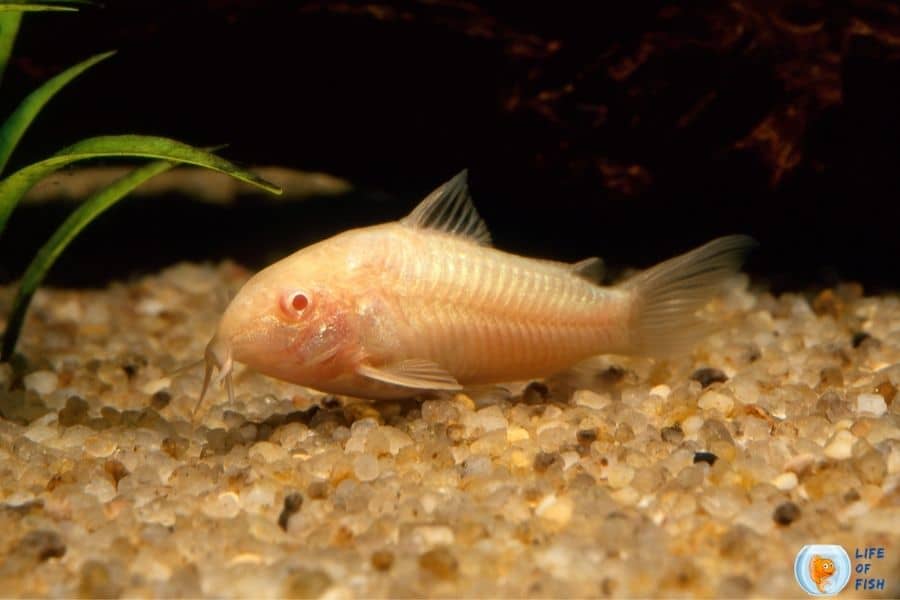
What is albino cory catfish
Jump To
- 1 What is albino cory catfish
- 2 How albino cory catfish looks like
- 3 Size of albino cory catfish
- 4 Lifespan of albino cory catfish
- 5 Male and female albino cory catfish
- 6 Where albino cory catfish live
- 7 Albino cory catfish care
- 8 Albino cory catfish behavior
- 9 What they eat?
- 10 Albino cory catfish breeding
- 11 How many albino cory catfish in a 10 gallon?
- 12 Related question
- 13 Conclusion
- 14 Reference
They, scientifically known as Corydoras aeneus, is one well-known Corydora among 170 recognized species of Corydoras.
They belong to the family Callichthyidae and specifically have albino colors; white to pink. Albino Corys have multiple barbels around the mouth, which aids them in the defense of other fish.
They are native to South America, found explicitly in the tributaries of the Amazon river.
Albino Cory catfish is also known as Armored catfish because they are heavily armored and have spines on their pectoral and dorsal fins.
These spines come with mild toxins. Therefore, handling these fish should be done carefully. Albino Cory Catfish is well suited in tropical freshwater community aquariums.
How albino cory catfish looks like
As the name suggests, Albino cory catfish is an albino color fish that grows up to two and a half inches.
They are small and very active fish species that are fun to watch, which is one of the reasons people love them.
Color
Albino cory catfish comes in various colors, mainly from white, pink, to red. The main trait of all these color variations is that they are albino.
Like any other albino-colored fish, Albino Corys have gentle crimson-colored eyes, and some people think they are blind, which they aren’t.
Shape
Like many other bottom-dwelling fish, they have a flat abdomen with a higher body frame.
They have sharp barbs around the mouth and in dorsal, pectoral, and adipose fins. These barbs contain mild toxins that can sting other fishes.
These poisonous barbs are a defense mechanism to be safe from attacking animals.
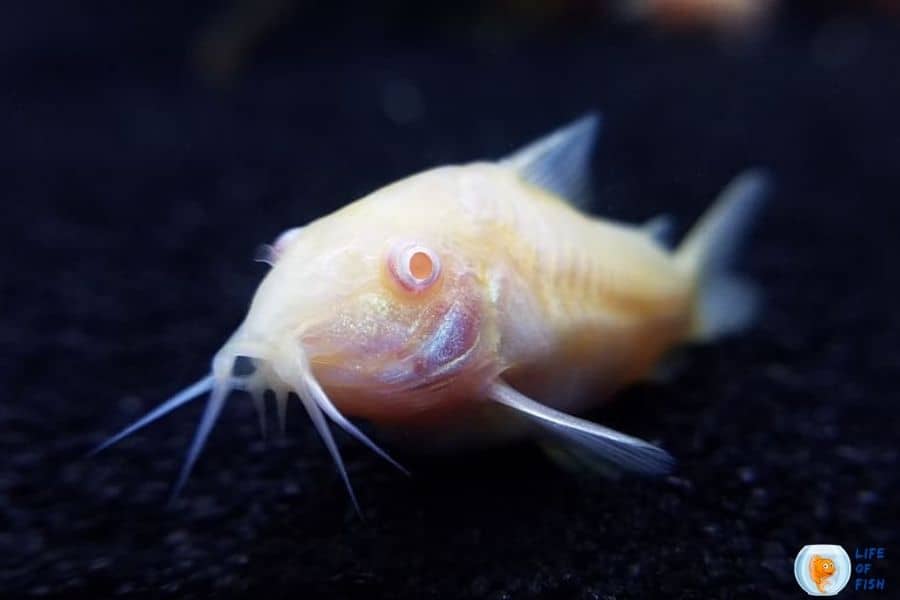
Size of albino cory catfish
The usual purchase size of these Corydoras is about one inch, whereas their maximum size is 2.5 inches. Like any other Corydoras, they are also small in size.
Lifespan of albino cory catfish
In optimum aquarium conditions, they will live for about five to eight years maximum. Considering their size, these fish live much longer than other fish types.
Male and female albino cory catfish
Like any other Corydoras, female fish are larger and have a slightly higher body frame than male fish.
Their abdominal region is more significant than males, which helps them carry eggs.
Where albino cory catfish live
Albino Cory catfish inhabits South America on the eastern side of the Andes, Colombia, Trinidad, and the Río de la Plata basin.
They are primarily found in the tributaries of the Amazon river in quiet, shallow waters with soft bottoms.
They can also live in waters heavily polluted by clouds of disturbed mud from the bottom and inhabit running water.
Like other Corydoras, Albino Corys can tolerate low oxygen levels in the water. Their gills have been utilized to breathe oxygen from both water and air.
So, in the periods of aquatic hypoxia, Albino Cory catfish rapidly come to the surface of the water and inhale breath through their mouth.
Albino Cory catfish can tolerate a temperature range of 25 °C to 28 °C (77 °F to 82 °F). The pH level of your corydoras tank should be 6 to 8, and the water hardness should be 5 to 19 DGH.
Albino cory catfish care
Albino Cory catfish are easy to care for fish species due to their high tolerance to polluted water conditions. This makes them beginner-friendly fish that are suitable for community tanks.
Tank requirement
Due to their higher activity, they need a larger aquarium compared with similar-sized fish.
They need at least a 20-gallon tank to thrive. As these are shoaling fish, they want to be in groups.
So, you have to put at least five Corydoras into the tank. You can put other types of Corydoras instead of the same species if you prefer but, they do best when kept in the same species.
Water quality
Unlike much other fish, Corydoras can tolerate polluted water conditions such as cloudy and muddy water.
They can breathe from water and air. So, they can endure low oxygen levels too. However, the optimum water conditions for Albino Cory catfish are;
Temperature: 77 °F to 82 °F (25 °C to 28 °C)
pH Level: 6.0-8.0
Hardness: 5-9 DGH
The water should be slightly acidic, and they can not live in brackish water.
Tankmates
They are compatible with any peaceful community as they are peaceful fish species.
As these fish are bottom-dwelling fish, they will not bother any middle or top-dwelling fish.
Keeping them in a planted aquarium is recommended as they can hide when they are threatened. Some suitable tank mates are,
- Mollies.
- Fancy Guppies.
- Neon Tetras.
- Angelfish.
- Danios.
- Platies.
- Swordtails.
- Gouramis.
They are also compatible with shrimps like Amano shrimp, Cherry shrimp, and Ghost shrimp.
Corydoras can also live with freshwater snails like Gold Inca Snails, Ivory Snails, Malaysian Trumpet Snails, Rabbit Snails, Japanese Trapdoor Snails, Mystery Snails, Ramshorn Snails, Pond Snails, and Nerite Snails.
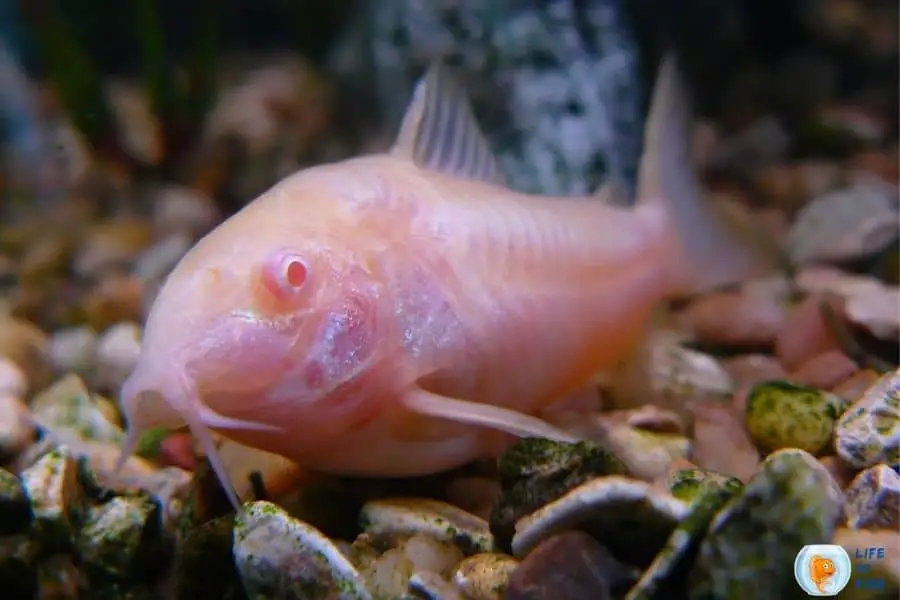
Albino cory catfish behavior
Albino cory catfish are calm, peaceful, and non-aggressive fish species that get along with any peaceful fish.
They are active bottom dwellers that occasionally swim to the water’s surface to breathe from the air.
If they consistently swim to the surface of the water, that indicates that the quality of water is poor. Unlike other bottom dwellers, they are highly active fish that school with their own species.
They may also school with other Corydoras species but do well with the same species. Albino Cory fish shoal together, scavenging leftover food.
They can also stay still in the same spot, resting and motionless. Overall, they are energetic, happy, and peaceful fish that are pleasant to watch.
What they eat?
Albino cory catfish are scavengers that eat leftover food that fall to the bottom.
they are not picky eaters and will eat anything they find that is soft and small enough to fit in their mouths because these fish are omnivores.
They especially like to eat worms of all types. So, you can feed with live or frozen blackworms, bloodworms, and Hikari Vibra bites.
You can also provide them with pellets, flakes, and algae wafers, and they will happily eat them.
Albino cory catfish breeding
Corydoras will usually be sexually mature when they are about 6 to 9 months old, but you should refrain from breeding until they are 2.5 inches long.
The breeding of Corydoras is actually an easy process. Albino cory catfish are egg layers that lay eggs to the substrate while spawning.
They don’t spawn unless they feel comfortable and secure. So, you have to provide a comfortable environment for them to spawn.
You can either use a breeding tank or let them breed in the community tank because other fish species don’t bother this fish while spawning.
However, if you let them breed in the community tank, you should observe and remove the eggs immediately to save them from the predators (including Corydoras themselves).
To breed Corydoras, you should condition them first.
Keep male and female Corydoras in separate tanks for about two weeks and feed them high-protein food like live and frozen bloodworms, brine shrimp, Blackworms, etc.
Once they are conditioned, you will notice more plumper female fish in the conditioning tank. Then you can put them into the breeding tank to spawn.
However, you should do a 50% water change and decrease the water temperature by 2 to 3 degrees Fahrenheit in the breeding tank before putting the fish together. This will induce the fish to spawn, and they will spawn within few hours.
While spawning, the female fish lay the eggs, and the male fish fertilize them with their sperms. Fertilized Cory eggs will hatch within 3 to 5 days.
If you spawn the fish in a breeding tank, you should remove the adult fish right after spawning. If you spawn the fish in the community tank, you should remove the eggs to a different container to save the eggs from eating.
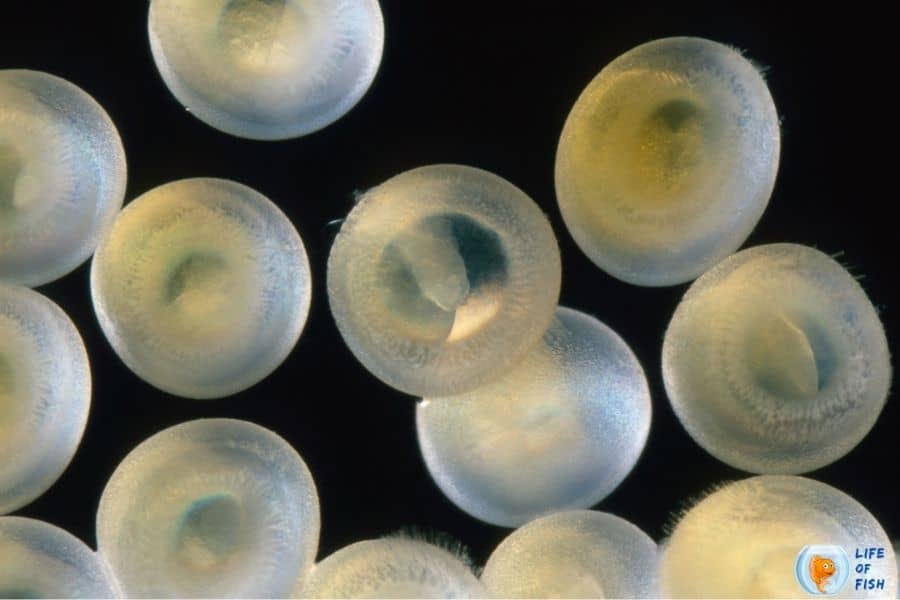
How many albino cory catfish in a 10 gallon?
Albino cory fish can not live in a 10-gallon tank. They need at least 20 gallons to thrive. If you keep Corydoras in a 10-gallon tank, they will suffer.
As they are highly active fish species, they need ample space to explore. Otherwise, they’ll get stressed and be vulnerable to diseases.
Related question
What kind of fish is an albino cory catfish?
They are small, peaceful, bottom-dwelling scavenger fish popular in the aquarium trade. They are omnivorous freshwater fish that help you keep the tank clean.
Can I keep albino cory catfish with a betta?
Yes. You can keep any species of Corydoras with betta fish. They are bottom-dwelling scavengers, and bettas are top-dwelling fish.
Although bettas are aggressive fish species, they do not bother exploring the substrate, so these two fish don’t encounter each other. That makes them compatible partners in a community tank.
Are albino cory catfish poisonous?
They carry some toxins in their barbels that can sting other fish as well as humans.
Although it is mild, the toxins can irritate and cause pain for several hours. It is most likely a bee sting. However, if you have allergies, you may experience more severe reactions to this toxin, but it is not fatal.
Are albino cory catfish blind?
Some people think that Albino Cory catfish are blind because of their eye color and behavior.
While some fish may be blind due to inbreeding, most catfish are indeed not blind. They just don’t care about the things around them and enjoy their surroundings in their own way.
That is why you don’t see any behavior change while you are present.
Why do Albino cory catfish swimming erratically?
Albino cory catfish are naturally crazy swimmers. They constantly search for food in the bottom and occasionally go up to breathe air from the surface.
While this behavior is normal, sometimes you will see some erratic behavior from your Corydoras.
They might be unusually swimming than before, gulping air from the surface and swim around like crazy. If you observe behavior like this, then it indicates a problem. Some of the reasons are,
Poor water condition
If the Ammonia, Nitrite, Nitrate, and pH levels are high, the changes may irritate the fish. Therefore they may swim like crazy.
Low Oxygen levels
Though Albino Cory can tolerate low oxygen levels, keeping them in this condition can be harmful to the fish. If the O2 level of water is scarce, Albino Cory catfish will swim to the surface frequently. If you notice frequent swimming to the top, then it is time to do a water change or increase oxygenation by adding more oxygen pumps.
Whirling disease
Whirling disease is a rare parasitic infection that affects freshwater fish. Myxozoan parasite Myxobolus cerebralis cause the infection. The symptom of this infection is radical tail-chasing swimming behavior. Unfortunately, there is no cure for this disease, and euthanasia of the fish is recommended.
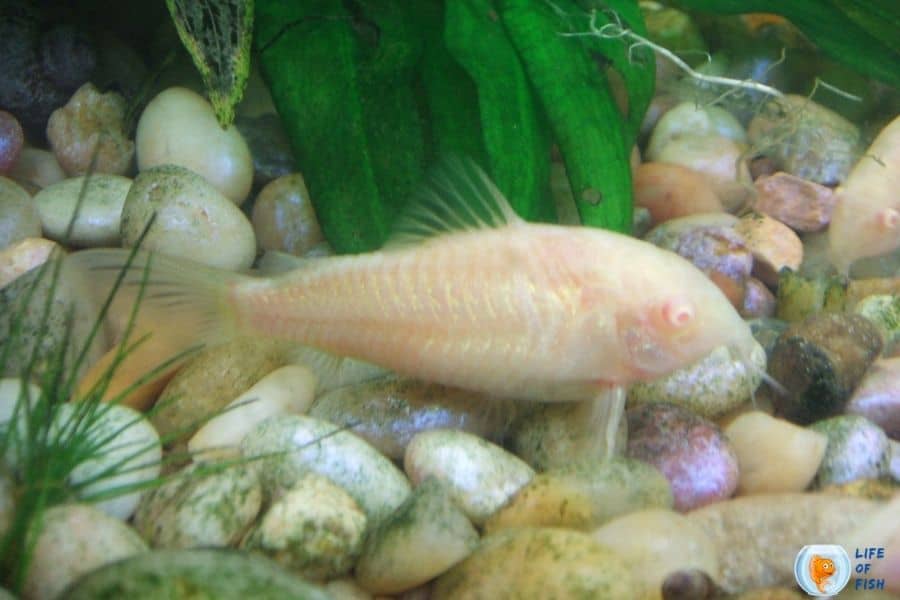
Conclusion
Albino Cory catfish are fascinating, energetic fish species that help you keep the aquarium clean by eating leftover food and debris that falls to the bottom.
They are peaceful and happy creatures that enjoy swimming actively around the tank. You can keep these fish with any friendly fish species, and they are easy-to-care fish because of their high tolerance.
Having a school of Albino Cory catfish is definitely an advantage if you want a cleaner, colorful and enthusiastic aquarium.
Reference
- Van der Walt, K.A., Mäkinen, T., Swartz, E.R. and Weyl, O.L.F., 2017. DNA barcoding of South Africa’s ornamental freshwater fish–are the names reliable?. African Journal of Aquatic Science, 42(2), pp.155-160.
- Kohda, M., Yonebayashi, K., Nakamura, M., Ohnishi, N., Seki, S., Takahashi, D. and Takeyama, T., 2002. Male reproductive success in a promiscuous armoured catfish Corydoras aeneus (Callichthyidae). Environmental Biology of Fishes, 63(3), pp.281-287.
Read Next: Mutton Snapper Fish | 10 Super Interesting Facts About The Fish
